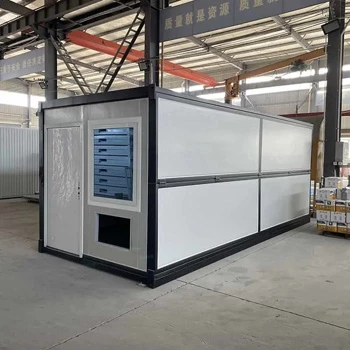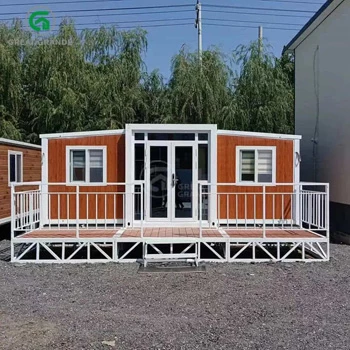دليل اختيار منزل الحاويات الموسع المحتويات
بدأ عدد متزايد من الأشخاص في فهم والتفكير في استخدام المنازل الحاوية كمساحات للمعيشة والعمل في سيناريوهات مختلفة. فكيف ينبغي للمرء أن يختار المنزل الحاوية المناسب لبيئات الاستخدام المختلفة؟
مواقع البناء منازل الحاويات الموسعة
مواقع البناء توسيع المنازل الحاويات تُستخدم عادةً كمهاجع للعمال، ومساحات مكتبية، وغرف تخزين، وما إلى ذلك. عند اختيار منازل الحاويات لمواقع البناء، يجب أن تتضمن الاعتبارات المتانة والتصميم المكاني وتكوين المرافق.
- متانة:بيئة موقع البناء معقدة، لذلك يجب أن تتمتع الحاوية بمقاومة للضغط والزلازل لتحمل الظروف الجوية القاسية.
- التصميم المكاني:اختر الحجم المناسب للحاوية بناءً على عدد العمال؛ عادةً، يمكن للحاوية التي يبلغ حجمها 20 قدمًا (حوالي 15 مترًا مربعًا) أن تستوعب 3-4 أشخاص، بينما تكون الحاوية التي يبلغ حجمها 40 قدمًا (حوالي 30 مترًا مربعًا) مناسبة للمجموعات الأكبر.
- تكوين المرفق:خذ بعين الاعتبار تجهيز الحاوية بالمرافق الأساسية مثل الحمامات والمطابخ حسب الحاجة.
مزارع منازل حاويات موسعة
حاويات متوسعة للمزارع يمكن أن تكون بمثابة منازل ريفية أو مساحات تخزين أو مساحات عمل. عند الاختيار، يجب مراعاة عوامل مثل الإضاءة والتهوية والعزل ضد الرطوبة واستغلال المساحة.
- التهوية والإضاءة:تحتاج بيئة المزرعة إلى تهوية جيدة وإضاءة طبيعية، لذا ينصح باختيار التصاميم ذات النوافذ وفتحات التهوية.
- عزل الرطوبة:نظرًا لارتفاع نسبة الرطوبة في المناطق الريفية، فإن العزل ضد الرطوبة أمر بالغ الأهمية. اختر الحاويات المصنوعة من مواد مقاومة للرطوبة أو المطلية.
- استغلال المساحة:حدد بوضوح الغرض من الحاوية واختر حجمها بناءً على عدد أفراد الأسرة أو العمال. عادةً، يمكن دمج الحاويات التي يتراوح طولها بين 20 قدمًا و40 قدمًا بطرق مختلفة لإنشاء مساحات متعددة الوظائف.
عائلات منازل حاويات موسعة
اكتسبت المنازل الحاوية للعائلات شعبية كبيرة بين العائلات في جميع أنحاء العالم في السنوات الأخيرة. وتشمل العوامل الأكثر أهمية التي يجب مراعاتها عند الشراء التصميم المكاني والديكور، يليه العزل والأداء الحراري.
- التخطيط المكاني: منازل الحاويات العائلية غالبًا ما تتطلب تصميمات تخطيطية أكثر تعقيدًا لتلبية احتياجات غرف النوم والحمامات والمطابخ وما إلى ذلك. يمكن دمج حاويات متعددة لإنشاء مناطق وظيفية مختلفة.
- عازلة:يجب مراعاة أداء العزل للمواد عند الشراء لضمان بيئة معيشية مريحة مع الدفء في الشتاء والبرودة في الصيف.
- ديكورات شخصية:تخصيص الديكور الداخلي والخارجي وفقًا لنمط العائلة لتعزيز جماليات وتجربة المعيشة في المنزل.
منازل حاويات موسعة للإسكان في حالات الطوارئ
في حالة الكوارث الطبيعية وغيرها من حالات الطوارئ، يمكن للمنازل الحاوية توفير مساحات معيشية مؤقتة بسرعة. بالنسبة لاحتياجات الإسكان في حالات الطوارئ، فإن المتطلبات الأساسية هي النشر السريع والإعداد الأساسي والقدرة على الحركة.
- النشر السريع:إعطاء الأولوية لاختيار الحاويات التي يمكن تجميعها وتفكيكها بسرعة للاستخدام الفوري عند الحاجة.
- المرافق الأساسية:تأكد من أن الحاوية مجهزة بمرافق المعيشة الأساسية، مثل الأسرة والطاولات، لتلبية احتياجات المعيشة اليومية الأساسية.
- الحركة:إذا كان ذلك ممكنًا، فاختر منازل الحاويات القابلة للتحريك لتسهيل النقل إلى مواقع آمنة حسب الحاجة.
الفنادق وبيوت الضيافة والمنازل الحاوية الموسعة
أصبحت المنازل المصنوعة من الحاويات تحظى بشعبية متزايدة كشكل من أشكال الفنادق وبيوت الضيافة، حيث تقدم تجربة فريدة للضيوف. عند الاختيار بيوت الحاويات للضيافةوينبغي أن تشمل الاعتبارات التصميم والوظيفة والاستدامة.
- التصميم والجماليات:اختر منازل الحاويات ذات التصميم الفريد والمريح لجذب الضيوف وتعزيز تجربة إقامتهم.
- المرافق الوظيفية:يجب أن توفر بيوت الحاويات الفندقية مرافق معيشية شاملة، مثل الحمامات المجهزة تجهيزًا جيدًا، وأنظمة المياه الساخنة، والمطابخ الصغيرة لزيادة الراحة للضيوف.
- الاستدامة البيئية:إذا كنت تهدف إلى جذب الضيوف المهتمين بالبيئة، فاختر المنازل المصنوعة من الحاويات المصنوعة من مواد معاد تدويرها والمصممة لكفاءة الطاقة.
عند اختيار المنازل الحاوية الموسعة، يجب مراعاة احتياجات الاستخدام العملي، والقدرة على التكيف البيئي، والتصميم المكاني، والجماليات، والتأكد من أنها قادرة على تلبية متطلبات سيناريوهات المعيشة أو العمل المحددة بشكل فعال. وبغض النظر عن نوع المنزل الحاوية المطلوب، فإن التخطيط والاختيار المعقولين سيوفران للمستخدمين مساحات معيشة مريحة وفعالة.






